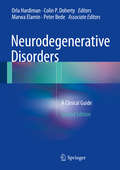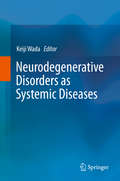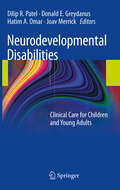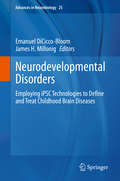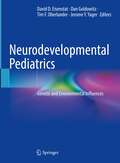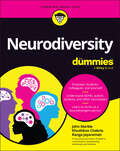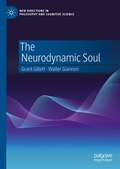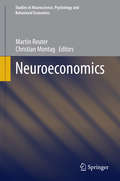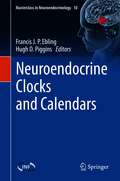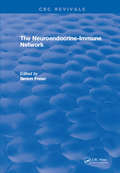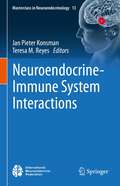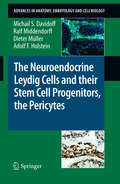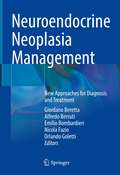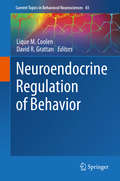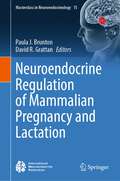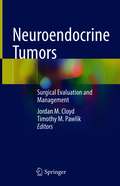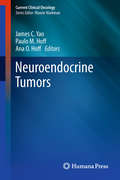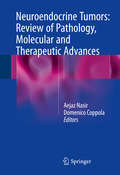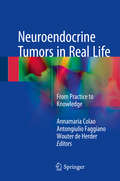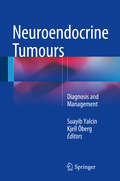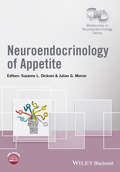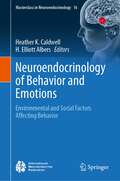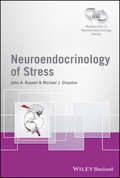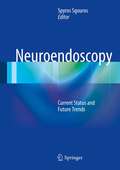- Table View
- List View
Neurodegenerative Disorders
by Orla Hardiman Colin P. Doherty Marwa Elamin Peter BedeThis new edition provides an accessible guide to the commonest neurodegenerative diseases, outlining the main clinical features, treatment options and outcomes of the conditions most frequently encountered in clinical practice. Beginning with an overview of the general principles that underlie degeneration, and the contribution of established and new diagnostics techniques, the book goes on to describe the most common neurodegenerative conditions and, new for the second edition, also HIV dementia and multiple sclerosis. Final chapters cover important management issues including the use of palliative care strategies, biomarkers and neuropsychology. Written by experts in the field internationally Neurodegenerative Disorders, Second Edition is a practical guide for clinicians that will be indispensable for the management of these conditions.
Neurodegenerative Disorders as Systemic Diseases
by Keiji WadaThis book sheds new light on neurodegenerative disorders as systemic diseases. Classically, neuronal cell death was a hallmark of such disorders. However, it has become evident that neural dysfunction is more important in the pathophysiology of neurodegenerative disorders. More recently, the prionoid-spreading hypothesis of disease-causing molecules has attracted a great deal of attention. Therapeutic strategies thus must be reconsidered in the light that neurodegenerative disorders are indeed systemic diseases. The first part of this book introduces the concept of neurodegeneration in biology and pathophysiology. The second part focuses on clinical evaluation and biomarkers from the perspective of this new concept, while the third summarizes the risk factors of neurodegeneration. The fourth part of this work indicates future directions of treatment, and the final part discusses health promotion for prevention and quality of life. This book will be of interest to both researchers and medical personnel, and provides a fresh approach to neurodegenerative diseases, paving the way to new research and improved quality of health care for patients.
Neurodevelopmental Disabilities: Clinical Care for Children and Young Adults
by Donald E. Greydanus Dilip R. Patel Hatim A. Omar Joav MerrickIncreasingly more and more children with developmental disabilities survive into adulthood. Pediatricians and other clinicians are called upon to care for an increasing number of children with developmental disabilities in their practice and thus there is a need for a practical guide specifically written for paediatricians and primary care clinicians that addresses major concepts of neurodevelopmental pediatrics. In the United States, the specialty training leading to a conjoint board certification by the American Board of Pediatrics and American Board of Psychiatry and Neurology, requires a total of 6 years of training (2 years of pediatrics, 1 year of neurology, 18 months of child neurology, 18 months of neurodevelopmental disabilities). As of December 2006, in the US, there were 241 pediatricians and 55 child neurologists certified in the subspecialty of Neurodevelopmental Disabilities. Thus most of the children with developmental disabilities are seen by pediatricians and therefore it is important for these pediatricians to be well informed of common issues in the field. The 60,000 or so pediatricians in the United States (and hundreds more in other countries) are the main target audience for a practical book on neurodevelopmental pediatrics.
Neurodevelopmental Disorders: Employing iPSC Technologies to Define and Treat Childhood Brain Diseases (Advances in Neurobiology #25)
by Emanuel DiCicco-Bloom James H. MillonigThis book contains a compendium of induced pluripotent stem cells (iPSCs) articles and reviews concerning state of the art technologies and how they are being applied to human neurodevelopmental disorders. With the establishment of effective technologies to produce iPSCs and their derivatives, like neural precursors, neurons, and glia, researchers have new platforms to study neurodevelopmental disorders. iPSC technology enables researchers to study how human neurons develop in individuals with neurodevelopmental disorders, providing an unparalleled opportunity to investigate their etiology. In turn, researchers have now begun to understand the underlying molecular and cellular pathways that contribute to human diseases. iPSCs technologies also provide an emerging tool for future translational studies and disease classification. The chapters will emphasize how among the diverse idiopathic and genetic disorders, there are common clinical as well as cellular and molecular phenotypes.
Neurodevelopmental Pediatrics: Genetic and Environmental Influences
by David D. Eisenstat Dan Goldowitz Tim F. Oberlander Jerome Y. YagerThis book explores the interrelationship of genetics, the environment, or both, in the causation of three neurodevelopmental disorders: autism/autism spectrum disorder (ASD), fetal alcohol spectrum disorder (FASD), and cerebral palsy (CP). It links common clinical problems in developmental pediatrics and pediatric neurology to current concepts and translational research advances in developmental neurosciences, medical genetics, and related disciplines. The first section of the book provides a comprehensive and up-to-date overview of development of the brain, including topics such as neuronal stem cells, epigenetics, and the influence of the prenatal environment. The next three sections analyze the epidemiology, diagnosis, interventions, and controversies and research directions associated with each of the three neurodevelopmental disorders. It also examines co-morbidities common to all three disorders, such as disturbed sleep, seizures, behavioral disorders, and pain. It concludes by highlighting the impact of ASD, FASD, and CP on family dynamics and provides tools and resources based on foundational concepts such as neuroethics, bioinformatics, community engagement, and advocacy. Learning objectives, key points, clinical vignettes, and multiple choice questions are incorporated throughout the book. With its comprehensive treatment of disease mechanisms, genetics, and pathophysiology associated with these disorders and its discussion of potential therapies and novel treatments, Neurodevelopmental Pediatrics: Genetic and Environmental Influences is an essential resource for developmental pediatricians, child neurologists, fellows, residents and graduate students.
Neurodiversity For Dummies
by John Marble Khushboo Chabria Ranga JayaramanA quick and easy way to understand neurodiversity as written by neurodivergent people and our families Neurodiversity For Dummies is your essential guide in understanding neurodivergent conditions like autism, ADHD, dyslexia, and more. This quick and easy guide is perfect for anyone needing to know more about neurodiversity. And that’s all of us—because recent estimates say that 15-20% of the world’s population have some form of neurodivergence. Your life is filled with neurodivergent people that you know and love, whether you realize it yet or not. It’s time to learn to support and include the neurodivergent among us, and to understand how neurodiversity impacts society and the workplace. This is for the neurodivergent person wanting to thrive in life, for parents and caregivers seeking success for their child, and for teachers who are working to make a difference in their students’ lives. Filled with practical advice, Neurodiversity for Dummies also provides a helping hand to service providers, assistance for workplace managers and colleagues, and understanding for family members and friends. Imagine a world where we all understood ourselves better and appreciated more deeply the differences in others. No matter how your own brain thinks, Neurodiversity for Dummies is for you. Check out this jargon-free introduction for an essential overview. Explore the Spectrum of Neurodiversity: Understand in plain language the world of autism, ADHD, dyslexia, and other neurodivergent conditions. Unlock Hidden Talents: Move yourself beyond common myths and misconceptions to discover how neurodiversity actually works. Learn how neurodiversity has always been with us, why society needs neurodivergent traits, and how neurodiversity can be a wellspring of innovation, creativity, and out-of-the-box thinking. Discover Yourself: Whether you are a neurodivergent person or not, learn how to understand your own normalcy, advocate for your needs, and build meaningful connections with those who think and experience the world differently than you. Change the World Around You: Be empowered through simple steps you can take to create inclusive environments for neurodivergent individuals in your school or workplace. Uncover proven strategies that cultivate a culture of acceptance and respect, where the unique perspectives of all individuals are valued and celebrated. We believe in providing parents with better supports, empowering individuals with information, and shaping a world where we are all seen and understood. With an author team composed of neurodivergent individuals and parents writing together, Neurodiversity for Dummies is an example of the power of neurodiversity when put into action. It’s why we wrote this for you. Don’t miss your chance to embark on this transformative journey. Order your copy of Neurodiversity for Dummies now to better understand yourself and others, and to join the movement that is revolutionizing how we understand and support the diversity of the human mind.
Neurodiversity Works: A Study Of Employees With ADHD, AS And PTSD
by Sarah E. H. BabineauThis research paper focuses on the experiences of employees with hidden disabilities in the workplace. Three cognitive disorders were studied, Attention Deficit Hyperactivity Disorder, Asperger's Syndrome, and Post-Traumatic Stress Disorder. Literature by experts on these subjects is reviewed and analyzed. Participants then describe their feelings and experiences in the workplace as they related to their conditions, and the two are juxtaposed in a final discussion. Emergent themes that resulted from the lines of questioning included the role played by manager and coworker support, accommodations under ADA and ADA Amendments Act, working environment, employee attitude, and whether the participants felt they had been treated fairly. Participants were asked to contribute to a quantitative survey instrument as well as a qualitative survey instrument that encouraged them to tell their stories in their own words. In some cases, these stories serve to help identify best practices in the workplace, and some serve to illustrate the obstacles and level of conflict, sometimes bordering on cruelty, that can exist for those with ADHD, AS and PTSD if negative behaviors and attitudes in the workplace are left unchecked. Human Resources practitioners and managers were also queried on the subject to obtain a rounded and full view of the challenges employees with these three hidden disabilities face, as well as those of the people who manage them.
The Neurodynamic Soul (New Directions in Philosophy and Cognitive Science)
by Grant Gillett Walter GlannonThis book is an analysis and discussion of the soul as a psychophysical process and its role in mental representation, meaning, understanding and agency. Grant Gillett and Walter Glannon combine contemporary neuroscience and philosophy to address fundamental issues about human existence and living and acting in the world. Based in part on Aristotle's hylomorphism and model of the psyche, their approach is informed by a neuroscientific model of the brain as a dynamic organ in which patterns of neural oscillation and synchronization are shaped by biological, social and cultural factors inside and outside of it. The authors provide a richer and more robust account of the soul, or mind, than other accounts by framing it in neuroscientific and philosophical terms that do not explain it away but explain it as something that is shaped by how it responds to the natural and social environment in enabling flexible and adaptive behavior.
Neuroeconomics
by Martin Reuter Christian MontagThis book represents one of the cornerstones of the series Studies in Neuroscience, Psychology and Behavioral Economics. It is divided into eight sections, starting with an introduction to neuroeconomics followed by an overview of frequently applied experimental paradigms (games) in neuroeconomics research. Furthermore, it addresses the molecular basis of human decision making, environmental/situational factors and social contexts influencing human decision making, as well as translational and developmental/clinical approaches to neuroeconomics. In closing, a paper on neuro-marketing demonstrates how knowledge from neuroeconomics research can be applied in "real life. " Culminating in an extensive methods section, in which eight different neuroscience techniques are introduced, the book offers an essential resource for researchers and practitioners, and may also be beneficial for graduate students.
Neuroendocrine Clocks and Calendars (Masterclass in Neuroendocrinology #10)
by Francis J. P. Ebling Hugh D. PigginsThis book explores how daily and seasonal rhythmicity is generated, how these rhythms are synchronised by our environment, and how they regulate the neuroendocrine systems that impact our physiology and behaviour. The constraints of surviving in a seasonal environment have shaped human evolution and migration, have shaped our societies and cultures, and continue to influence our everyday lives, health and wellbeing. Identifying the mechanisms whereby seasonal rhythmicity is generated and regulates the brain and body is not only important for understanding the natural world and relevant to animal production, it also offers many insights into the human condition. Each chapter is written by an international expert in the field of chronobiology. A historical perspective on how research into photoperiodism and rhythmicity progressed is initially provided, but the main focus of this book is on the remarkable studies in the last few decades that have unravelled the molecular and cellular machinery underpinning circadian and circannual timing. Topics covered include the role of melatonin in communicating seasonal information to the brain and pituitary gland, the neuroanatomical pathways in mammals, birds and fish by which changes in photoperiod reach the hypothalamus, the role of glial cells (tanycytes) and thyroid hormone in seasonal rhythmicity, neuroplasticity across seasons, effects of changing day length on mood, regulation of “clock“ gene expression, and the role of the suprachiasmatic nucleus. This book will appeal to all students and researchers who wish to learn about current and past research on daily and seasonal rhythmicity. This is the tenth volume in the International Neuroendocrine Federation (INF) Masterclass in Neuroendocrinology series (Volumes 1-7 published by Wiley) that aims to illustrate highest standards and encourage the use of the latest technologies in basic and clinical research and hopes to provide inspiration for further exploration into the exciting field of neuroendocrinology.
The Neuroendocrine Immune Network
by S. FreierThis informative publication updates the study of interaction of the nervous and endocrine systems with the immune system in the body. It describes the anatomical basis of these interactions, reviewing the innervation of lymphoid tissue and mast cells. The book discusses the effect of the endocrine system on immune function, including the relation of sex to the immune response. Emphasis is given to opioids, substance P, neurotensin, vasoactive intestinal peptide, somatostatin and cholecystokinin. Also addressed is the immunoregulatory effect of leukotrienes and platelet-activating factors. Scrutinized within are stress as an aspect of neuro-immune interactions, and the central role of the hypothalamus in this context. The book reviews the eye and the gastrointestinal tract with respect to the coordination of the nervous, endocrine, and immune systems in serving these organs. This work is of particular value to those in immunology, endocrinology, gastroenterology, and developmental biology.
Neuroendocrine-Immune System Interactions (Masterclass in Neuroendocrinology #13)
by Jan Pieter Konsman Teresa M. ReyesThe concepts of the neuroendocrine system and the immune system emerged more or less simultaneously in the second half of the 20th century. Although these systems have a high degree of autonomy, it has also become clear that they interact in many ways and at different levels. This book focuses on the neuroendocrine and immune interactions that are fundamental to normal development and maintenance of health.The first introductory chapters are devoted to the historical and philosophical concepts within the field, as well as evolutionary considerations, offering critical interdisciplinary perspectives on the development of this field of research. Without attempting an exhaustive overview, the book then introduces some of the regulatory pathways that mediate interactions between the neuroendocrine and immune systems and examines modulating factors such as age and sex. In addition, several chapters address the importance of neuroendocrine-immune interactions in some disease states. Readers can expect to gain a broad perspective of neuroendocrine-immune interactions in development, health, and disease, along with a critical evaluation of current methods used in the field. Given its scope, the book is essential reading for undergraduate and graduate students with an interest in neuroendocrinology, neuroimmunology, and neuroscience, as well as postdoctoral fellows and established researchers seeking a comprehensive overview and historical perspective of the field of neuroendocrine-immune interactions.
The Neuroendocrine Leydig Cells and their Stem Cell Progenitors, the Pericytes
by Adolf F. Holstein Ralf Middendorff Michail S. Davidoff D. MüllerThe discovery of the neuroendocrine features of Leydig cells gave rise to the hypothesis of a potential neuroectodermal and/or neural crest origin of testicular Leydig cells. In an experimental animal model the authors revealed that adult Leydig cells originate by transdifferentiation from stem/progenitor cells (pericytes and smooth muscle cells), underlying the close relationship of Leydig cells with testis microvasculature. This and the supporting data from the literature provided the basis for revealing the pericytes as a common adult stem cell type of mammalian species. Distributed by the microvasculature through the entire body, the pericyte, acting as a resting early pluripotent adult stem cell, provides an ingenious system to assure the maintenance, physiological repair and regeneration of organs, each under the influence of specific local environmental factors.
Neuroendocrine Neoplasia Management: New Approaches for Diagnosis and Treatment
by Giordano Beretta Alfredo Berruti Emilio Bombardieri Nicola Fazio Orlando GolettiThis book provides the most recent update on the management of neuroendocrine neoplasia (NEN), a term covering all tumors of various organs and/or with a particular histology, including MEN (multiple endocrine neoplasia) related tumors, MiNEN (mixed neuroendocrine-non-neuroendocrine neoplasms), NEC (neuroendocrine carcinoma) and Merkel’s carcinoma. NENs are heterogeneous in their biology, clinical presentation and prognosis, showing a great variability in aggressiveness and therapy response. As a result, their treatment is based on a large spectrum of options. The standard therapies are surgery in early disease, various loco-regional procedures in certain conditions and mostly of a palliative nature in metastatic disease. At present, thanks to our increased understanding of molecular signaling pathways, several pharmacological approaches can be used in patients with advanced NENs. Somatostatin analogs display both anti-tumor effects and symptom control. Novel peptide-radio-receptor treatment (PRRT) is used in patients with well differentiated tumors. The agents targeting angiogenesis and/or PI3K/AKT/mTOR pathway, alone or in combination with analogues, have provided encouraging results in advanced disease. The first part of the book focuses on the history, epidemiology and the most relevant scientific achievements, covering the discoveries in genetic and molecular biology, the endoscopic techniques with guided biopsy, and the metabolic imaging with hybrid PET/CT and MRI/CT. It particularly highlights the emerging strategies in therapy, surgery and mini-invasive surgery as well as loco-regional and systemic treatments, including targeted therapy and/or biological therapies. The second part then explores the management of NENs of various anatomical origins and/or with peculiar biology. It describes the range of the current options and the most relevant results from the clinical trials. This informative book provides valuable insights for all those interested in the management of neuroendocrine neoplasia.
Neuroendocrine Regulation of Behavior (Current Topics in Behavioral Neurosciences #43)
by Lique M. Coolen David R. GrattanThis special volume provides twelve contributions that discuss different aspects of social and endocrine behaviors with an emphasis on the neural regulation of these behaviors. In addition, several review chapters address the neural plasticity that results from exposure to hormones or the experiences with the behavior. Finally, each of the contributions emphasizes future directions and incorporation of newly developed neuroscience techniques and approaches.
Neuroendocrine Regulation of Mammalian Pregnancy and Lactation (Masterclass in Neuroendocrinology #15)
by David R. Grattan Paula J. BruntonAdaptations to maternal physiology are required for a successful pregnancy outcome. These changes are primarily orchestrated by the mother’s brain and involve multiple neuroendocrine systems. For this book, the editors have gathered internationally recognized experts who have contributed to the major advances in our understanding of different aspects of the neuroendocrine regulation of mammalian pregnancy and lactation. The book begins with a discussion of how pregnancy is recognized and maintained and the role of the placental hormones in supporting key adaptations required for a successful pregnancy. The next few chapters focus on the neuroendocrine adaptations that occur during pregnancy in some key regulatory processes to ensure a sufficient supply of energy and nutrients, protect the fetus from potentially harmful maternal stress hormones, and prepare mammals for birth, milk production, lactation and motherhood. Finally, our current understanding of how the significant peripartum hormonal changes contribute to the mother’s cognitive function and mood is examined. This book provides a broad overview of the finely orchestrated neuroendocrine adaptations that occur in pregnancy and lactation and discusses how such changes contribute to maximizing the likelihood of a positive outcome for mother and infant. Importantly the evidence for involvement of neuroendocrine dysregulation in some pregnancy-related complications, such as preterm birth and perinatal mood disorders is also highlighted. In addition to addressing fundamental mechanisms in the regulation of mammalian pregnancy and lactation, the book includes the most recent advances in the field made possible by utilizing the latest innovative research technologies. Moreover, it provides opinions on optimal experimental approaches, relates findings from experimental animal models with those from humans, and outlines the direction and opportunities for future research in this arena. It is an essential resource for undergraduate students, postgraduate students, and early career researchers embarking upon their journey in the fields of neuroendocrinology, endocrinology, reproductive biology or behavioural neuroscience. It also provides a valuable synopsis for established neuroendocrine researchers and educators, especially those whose interest transcends the nexus between neuroendocrinology and reproductive biology. This is the 15th volume in the International Neuroendocrine Federation (INF) “Masterclass in Neuroendocrinology” series, which aims to illustrate the highest standards and to encourage the use of the latest technologies in basic research and hopes to provide inspiration for further exploration into the exciting field of neuroendocrinology.
Neuroendocrine Tumors: Surgical Evaluation and Management
by Jordan M. Cloyd Timothy M. PawlikThis book is a comprehensive, state-of-the art, definitive reference for the surgical management of Neuroendocrine Tumors (NETs). It provides a practical, clinically useful guide that prioritizes the diagnostic work-up, indications for surgery, surgical principles, and perioperative care of patients with NETs in the context of multi-disciplinary care. Most textbooks on NETs have traditionally focused on patients with advanced disease, highlighting systemic therapies and emerging treatment options. In contrast, this book provides a concise yet comprehensive summary of the surgical management of NETs and serves as an invaluable resource for physicians, fellows, and residents who treat this difficult disease by providing helpful guidelines and up-to-date information on clinical management. Written by experts in the field, Neuroendocrine Tumors includes the most up-to-date clinical information from national and international leaders in their respective disciplines. It not only serves as an invaluable resource for many as they seek to provide the best possible surgical and multidisciplinary cancer care, but also an opportunity to identify new avenues of scientific discovery that may lead to significant advances in the diagnosis and management of NETs.
Neuroendocrine Tumors
by Paulo M. Hoff James C. Yao Ana O. HoffNew research has shown that neuroendocrine tumors are more common than previously thought. Progress in our understanding of the molecular pathogenesis of these not-so-rare cancers has resulted in renewed interest in developing innovative therapeutic options. In particular, novel molecular targeted agents have been shown to have significant anti-tumor activity, and integration of these therapies has led to critical advances in management. In this volume, an outstanding group of the world's leaders in the field have assembled to convey their knowledge of the epidemiology, biology, and management of all the major types of neuroendocrine tumors. The book takes a multi-modality approach to understanding disease processes and therapeutics, including chapters on medical and surgical treatment as well as a chapter devoted to imaging. Throughout, the authors emphasize recent advances in our understanding of molecular biology and the subsequent emerging therapeutic options.
Neuroendocrine Tumors: Review of Pathology, Molecular and Therapeutic Advances
by Aejaz Nasir Domenico CoppolaThis text brings together the diagnostic and clinical expertise of an outstanding team of practicing neuroendocrine pathologists and oncologists. The case-based review format provides a practical diagnostic and therapeutic approach to illustrate real-life examples of a diverse range of neuroendocrine tumors that were diagnosed and worked-up in the multi-disciplinary setting of one of the leading academic cancer centers in the United States. In addition to the clinic-pathologic and molecular advances in the field of neuroendocrine oncology, this book focuses on the newer histological grading schemes by the North American NeuroEndocrine Tumor Society (NANETS), European NeuroEndocrine Tumor Society (ENETS) and the World Health Organization (WHO) and the recently proposed pathologic staging systems by the AJCC, WHO and ENETS. Individual case discussions are integrated with pertinent progress in molecular characterization of these unusual neoplasms. The balanced case content allows the reader to develop a comprehensive and practical understanding of the current trends in the pathology and molecular diagnosis of neuroendocrine neoplasms. Neuroendocrine Tumors: Review of Pathology, Molecular and Therapeutic Advances will be of great value to anatomic pathology (histopathology) residents, fellows, surgical pathologists, oncologists and surgeons in academia and community settings.
Neuroendocrine Tumors in Real Life
by Annamaria Colao Antongiulio Faggiano Wouter De HerderThis book on neuroendocrine tumors (NETs) aims to present, in a clear and innovative manner, a broad topic that is still unevenly and in some respects poorly delineated. The novel feature is the nature of the focus on the principles of prognosis, diagnosis, and therapy, which are outlined on the basis of well-defined clinical scenarios described with the aid of high-quality images and illustrations. The salient observations to emerge from the reported clinical cases are clearly summarized, taking into account evidence from the literature and the available guidelines. All of the significant prognostic factors – histopathological, molecular, and imaging – and current diagnostic and therapeutic strategies for the major NETs (stomach, pancreas, ileum, appendix, bronchus) are covered. In addition, in the introductory part of the book the reader will find information on basic aspects including epidemiology, classification, and underlying biological mechanisms. Neuroendocrine Tumors in Real Life will be of interest to all specialists involved in the management of NETs; it will provide the experienced with important updates and equip trainees and students with a firm understanding of key concepts.
Neuroendocrine Tumours
by Suayib Yalcin Kjell ÖbergThis book is a timely textbook that covers all aspects of neuroendocrine tumors (NET) from epidemiology, pathological classification and evaluation and molecular biology through to diagnostic imaging methods and therapeutic options, including the latest targeted therapies. The various types of NET are individually discussed, including carcinoid tumors, insulinomas, gastrinomas, glucagonomas, VIPomas, somatostatinomas, PPomas, medullary thyroid carcinomas, adrenocortical cancer, pheochromocytomas, paragangliomas and non-functioning pancreatic NETs. The contributing authors are internationally recognized experts who bring a wealth of experience to the subject. This book will be an invaluable source of information for practicing medical oncologists, surgeons, endocrinologists, gastroenterologists and pathologists and also trainees.
Neuroendocrinology of Appetite
by Julian G. Mercer Suzanne L. DicksonThis cutting-edge, interdisciplinary volume describes established and state of the art approaches for exploring the pathways that influence and control appetite, including: behavioural, electrophysiological, neuroanatomical, gene knockout and pharmacological techniques. The book presents key peptide and neurotransmitter systems, together with newly emerging concepts of metabolic signalling and hypothalamic inflammation. The impact of early life experience on neuroendocrine appetite circuits is also looked at, including early programming of these circuits by circulating hormones. Finally, new emerging therapeutic approaches to appetite suppression are discussed, including those linked to bariatric (weight loss) surgery. Neuroendocrinology of Appetite is especially focused on established and emerging technologies and approaches for investigating appetite control. It is written so as to provide an overview of sufficient depth for an undergraduate or new scientist in the field to come up to speed in the complementary approaches used by researchers in this field. Taking an interdisciplinary approach, the book aims to appeal to all those with a basic, clinical or therapeutic interest in research into obesity and eating disorders.
Neuroendocrinology of Behavior and Emotions: Environmental and Social Factors Affecting Behavior (Masterclass in Neuroendocrinology #16)
by Heather K. Caldwell H. Elliott AlbersThis volume highlights current research on how the neuroendocrine system helps to influence emotional states and ultimately behavioral output. Social relationships and context-appropriate behavioral responses are important for the survival of most vertebrate species. These relationships can range from transient social interactions to strong social bonding between sexual partners and social behaviors can be observed and evaluated from the individual- to the group-level. Further, behavioral output is shaped by complex interactions between the physical environment, genetics, experience, and context, and are often modulated by the neuroendocrine system. In this book, experts in the field will provide a sweeping look at novel research in the neuroendocrine regulation of important behaviors ranging from parental care to social homeostasis, with a focus on comparative studies across vertebrate species. The first part of the book is dedicated to theneuroendocrinology of relationships, including the coordination of acoustic signals in songbirds, the complexity of social relationships in primates, and cooperation and parenting in humans. The second part of the book focuses on social behaviors and provides some insights into their regulation, including the neuroendocrine regulation of maternal behavior in rodents, the roles of oxytocin and vasopressin in the modulation of sex-specific social behavior, the interactions between adult neurogenesis, the neuroendocrine system and social behavior, and a consideration of neuroendocrine influences on reproductive decision making across species. The book concludes with a section on environmental influences on neuroendocrine systems underlying behavior, including how social isolation and endocrine disrupting chemicals affect the neuroendocrinology of behavior and emotions. Given its breadth, this volume is appropriate for undergraduate students, graduate students, postdoctoral researchers, and established researchers who are interested in neuroendocrinology and behavior. This is the sixteenth volume in the International Neuroendocrine Federation (INF) Masterclass in Neuroendocrinology series, which aims to illustrate the highest standards and highlight the latest technologies in basic and clinical research and aspires to provide inspiration for further exploration into the exciting field of neuroendocrinology.
Neuroendocrinology of Stress
by Michael J. Shipston John A. RussellExposure to chronic stress has cumulative adverse effects on physical and mental health, considered to be the consequence of chronic exposure to high levels of stress hormones. Consequently, there is extensive research in progress to investigate and better understand how the brain organises neuroendocrine stress responses and how interventions may be able to moderate these responses to improve mental and physical health. Neuroendocrinology of Stress highlights current knowledge of the organisation and physiology of these stress response systems, how the impact of dysregulation of these systems is being investigated, and considers the ways in which contributions to both psychiatric and physical diseases resulting from chronic stress effects can be critically addressed in basic research * Written by a team of internationally renowned researchers, each chapter presents a succinct summary of the very latest developments in the field* Both print and enhanced e-book versions are available* Illustrated in full colour throughout This is the second volume in a new Series 'Masterclass in Neuroendocrinology' , a co- publication between Wiley and the INF (International Neuroendocrine Federation) that aims to illustrate highest standards and encourage the use of the latest technologies in basic and clinical research and hopes to provide inspiration for further exploration into the exciting field of neuroendocrinology. Series Editors: John A. Russell, University of Edinburgh, UK and William E. Armstrong, The University of Tennessee, USA
Neuroendoscopy
by Spyros SgourosAs a result of technological improvements, neuroendoscopy is now used in the treatment of many more patients, enabling the performance of previously unavailable operations with low complication rates and rapid patient recovery. This book presents the distilled experience of world experts in this evolving field. Current applications in a wide variety of settings are explained in detail and likely future developments are identified. In addition, the available neuroendoscopic instruments are reviewed and the results of international trials and collaborative studies, presented. This book will fully acquaint the reader with the breadth and depth of available neuroendoscopy techniques and their impressive therapeutic potential. It should serve as the reference book on neuroendoscopy for the next 10 years.
